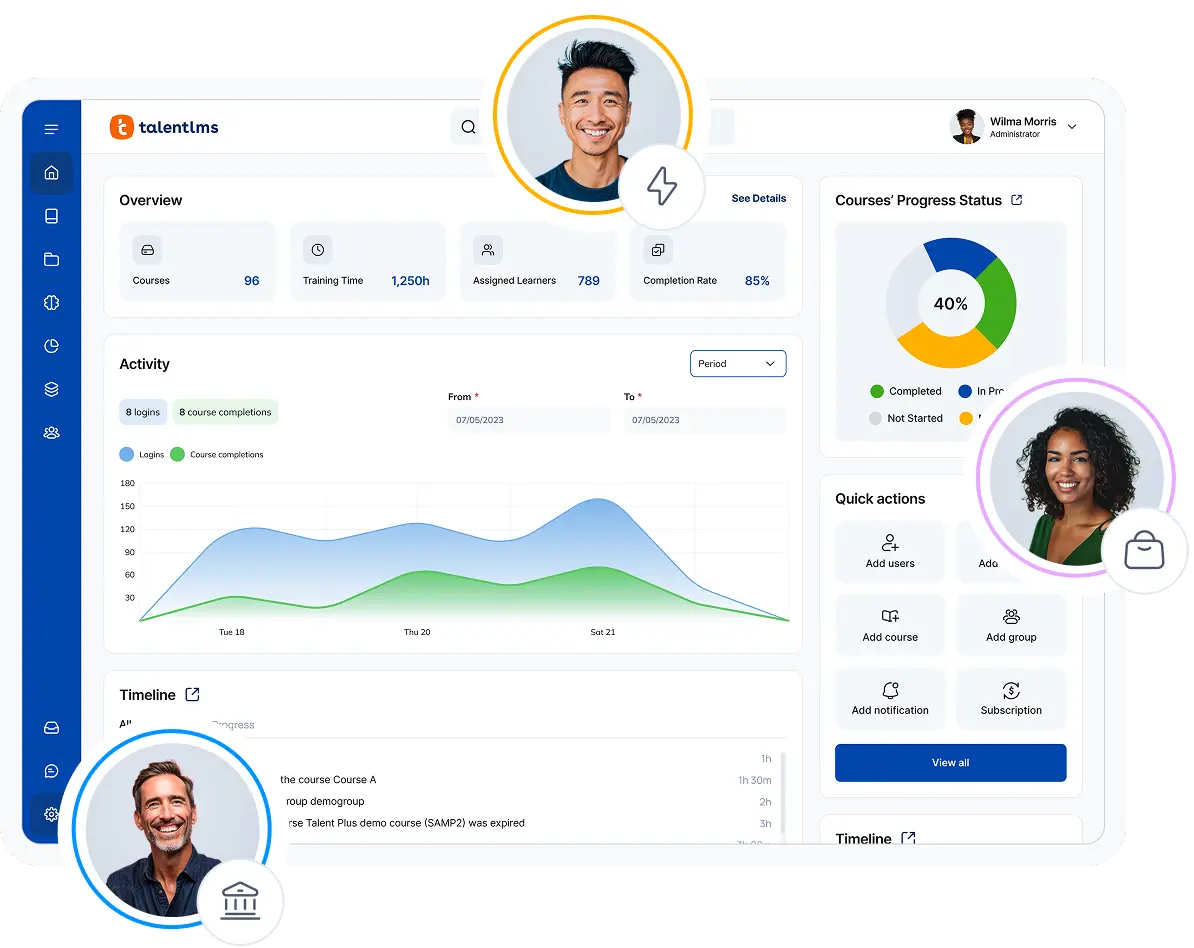Imagine that you are about to launch a digital training program to address a skills gap within your company. You plan to roll out the program over a six-month period, with access to online training videos and self-paced modules for your employees.
After all that work, will you dust your hands and never look back? Or will you just cross your fingers and hope for the best? I assume, neither. Instead, you’ll want to ensure your learning and development (L&D) initiatives are a great success.
Measuring training effectiveness requires a focused strategy. Without it, you might be implementing courses that don’t move the needle for your employees or your business’s bottom line.
But, knowing how to measure training effectiveness gives you a clear roadmap to evaluate your L&D initiatives. The feedback you get helps you make data-driven decisions about future programs, continually improving the training you offer to employees. You’ll also have the perfect answer the next time an executive or another stakeholder asks how corporate training leads to improved business performance.
You now have an overview of measuring training effectiveness. Let’s dive into the different ways you can assess learning outcomes and the overall value of your training efforts.
What is training effectiveness?
Training effectiveness refers to the quality of a training program and its impact on individual employees, teams, and an organization. Essentially, it’s a way to measure if a learning initiative has produced successful results.
Typically, you can evaluate training effectiveness through various means, such as:
- pre- and post-training assessments
- performance metrics
- Return On Investment (ROI)
However, training effectiveness is not just a numbers game. You also need to consider intangible results, like:
- surveys and feedback
- implementation of acquired skills
- behavioural changes
Measuring effectiveness is a vital aspect of your L&D initiatives, right? But why?
Why is it important to measure training effectiveness?
Training is a significant investment for many businesses. The average company spends $1,280 per employee on workplace learning, according to a recent report by the Association for Talent Development. Whether you spend more or less than that average, it makes sense that you want to make sure you’re getting a substantial return on your training investment.
When you consistently measure training effectiveness, it can have many advantages for your L&D initiatives. Measuring training effectiveness can have the following benefits for your employee training and development programs.
1. Increased ROI
Does your company’s leadership team have concerns about investing money in L&D? Sharing a program’s ROI can quickly silence the doubters in your organization. But, in order to do so, you must have the data to prove an organization’s training effectiveness.
Metrics like sales, profit, and revenue can all show a program’s ROI, but they aren’t the only standards of measurement. Other metrics, such as behavioral changes and performance improvement, can also show a strong ROI for the training provided.
When you know the ROI, you can use this information to encourage buy-in from executives and directors about the value of employee training. What’s more, you can also use ROI metrics to advocate for continued investment in employee development. You can use this data to justify putting time, resources, and money into future training initiatives.
2. Resource optimization
Training programs are indeed very important to employees and companies alike. But, inefficient training ultimately means a waste of resources. Two important examples:
- Time: Allocating time to training means less capacity for core activities. This applies to anyone creating the training, as well as, taking it. Thus, if a training is not relevant or doesn’t address learning needs, it can hinder productivity.
- Money: Investing in the best LMS for employee training is crucial. It could make or break your training efforts. Without the proper tools, it won’t be possible to get a “yes” from budget approvers, stakeholders, and employees.
3. Improved future training programs
Let’s say you implement a customer service training program and choose to measure its effectiveness by comparing customer satisfaction scores before and after its completion.
If the post-training scores show great improvement, then you know that your efforts have been rewarded. And it’s a great way to ensure that by replicating the program to other employees, teams, or departments, you can achieve the same level of success.
On the other hand, if the scores show little to no improvement, you can evaluate why the program didn’t have the expected outcome. Maybe the trainees didn’t have enough time to practice interactions in a simulated environment. Or the content wasn’t engaging enough and participation was low. Whatever the reason, you can make adjustments to the program to ensure future success.
Evaluating training effectiveness can show you what you’re doing right—and where you have room for improvement. When you measure the effectiveness of a program, you can review data and feedback to make adjustments in the future.
4. Enhanced performance and productivity
Ultimately, whether training is effective comes down to one core question: have employees benefited from it?
By measuring training effectiveness, you can discover whether a training program has improved employees’ skills and performance. High-quality, relevant training can empower your employees with the tools they need to grow and excel.
It can also help employees to not only progress up the career ladder, but it could broaden their horizons with lateral shifts within the organization. For companies, this means building a stronger, more diverse workforce.
5. Employee satisfaction and retention
When employees have the right training to thrive in their roles, it can have far-ranging impacts on a business. Not only can it boost job satisfaction and workplace morale, but it can also contribute to a stronger bottom line.
Gallup research shows that when organizations strategically invest in employee development, they report 11% more profitability. Plus, those companies are twice as likely to retain their employees, leading to significant cost savings related to recruiting, hiring, and onboarding.
Kirkpatrick training evaluation model
You know the benefits of evaluating training effectiveness, but how do you get started? While there are several training evaluation methods you can implement, one of the most popular is the Kirkpatrick evaluation model. This well-known model uses four levels to evaluate a corporate training program.
Let’s take a closer look at each level to help you understand how to measure training effectiveness using the Kirkpatrick model.
Level 1: Reaction
In this level, you measure participants’ reaction to the training. You collect feedback to determine whether employees found the training to be helpful and relevant. You can get this reaction by having discussions with employees or using feedback forms, such as surveys.
Some questions you might ask to evaluate employees’ reaction to a learning program include:
- How do you rate the quality of the content provided during your training?
- Did the training sessions move at a good pace, and were they easy to follow?
- How informative was the course content?
- Did you find the instructor’s delivery engaging?
- If you could improve the course, what would you do differently and why?
- Would you recommend this course to others?
As you can see, it’s important to ask questions about a variety of topics that are not limited to the training content itself.
Remember, tailoring the questions based on your evaluation metrics will give you the insights you need to measure the effectiveness of your training.
Level 2: Learning
The next level of the Kirkpatrick model helps you measure how much employees have learned from the training. It focuses on a fundamental question: has the training met its intended targets? To evaluate this level, you can use pre- and post-training assessments, interviews, or employee performance reviews.
Level 3: Behavior
In the behavior stage, you assess whether a learning transfer has occurred after the training. In other words, you look to see whether employees have put their newly acquired skills or knowledge into practice.
The behavior level is a key indicator of whether the training has the potential to make a long-term impact on a team or an organization. You can measure behavior change using a variety of methods, including:
- Questionnaires with open-ended questions
- Focus groups
- One-on-one discussions
- Supervisory reviews
- On-the-job observations
Level 4: Results
The last level evaluates the results of a training course and how those outcomes contribute to business performance. While the goals of corporate training can vary, some common evaluation metrics include sales, productivity, customer satisfaction, and employee retention.
In this stage, you collect feedback not only from employees who participated in the training but also from key stakeholders, like managers or department heads. This feedback can show you the perception that stakeholders have about the training’s value and effectiveness.

How to measure training effectiveness: 6 best practices
The Kirkpatrick model isn’t the only one you can follow, but it’s a good one to know because it approaches training evaluation in a holistic way. However, you may not need to measure each level for every employee training program you implement.
A one-day communication skills workshop, for example, may have benefits for employees, but it’s unlikely that it will boost sales or dramatically improve customer satisfaction. In this case, you might choose to focus on collecting data and feedback related to the reaction and learning stages, rather than behavior changes and business results.
For this reason, it’s helpful to follow these best practices on how to measure training effectiveness.
1. Know your goals
You can’t measure the training’s effectiveness if you don’t have a crystal-clear understanding of its intended objectives.
Before you do anything else, define the goals of the training. In the development phase, ask yourself what you want employees to learn and how that aligns with the company’s business goals. Once you define that, you can determine how to measure the training process effectively.
2. Identify KPIs
The key performance indicators (KPIs) you choose to measure will provide valuable insights into the training effectiveness. Identify KPIs that relate to the goals you have for the L&D initiative. Consider which level(s) of the Kirkpatrick model you want to evaluate and choose relevant KPIs.
Some common KPIs for employee training include:
- Attendance rates: If you offer optional training programs for employees, like a leadership development program, the attendance rate can tell you whether employees are interested in taking advantage of the opportunity. It measures how many employees sign up and continue attending a course.
- Completion rates: Like its name suggests, this KPI shows the rate of people who complete the training or course. Completion rates can tell you whether employees felt engaged and excited about the training.
- Pass/Fail rates: After the training, you can assess the quality of the program by determining the pass/fail rate. You can use post-training quizzes or assessments to test learners’ progress and their knowledge of the training material.
- Learner satisfaction: Employees who feel like they got something from the training are more likely to apply the skills they’ve learned to their work. It makes them feel motivated to get creative and try new things. Use this KPI to make sure you’re offering training programs that employees find beneficial.
- Job impact: You can measure various training KPIs related to job impact, such as sales closing rates or customer satisfaction scores. This type of metric shows you whether the training has a direct impact on employees’ job performance.
3. Choose evaluation methods
Once you know the KPIs you want to measure, choose the methods you’ll use to collect and assess this data. For the best results, pick a combination of methods that correlate to the KPIs you’ve identified. While these may look different for each program you implement, some evaluation methods include:
- Pre- and post-training assessments
- Employee surveys
- Interviews
- Focus groups
- Performance evaluations
- Peer reviews
- Workplace observations
4. Measure data over time
It’s important to collect feedback immediately after the training ends, while the material is still fresh in employees’ minds. You might choose to host a focus group, for example, within a few days of the course to collect feedback on the quality of training materials or the instructor’s teaching methods.
Don’t stop collecting data after the training ends. Create a data collection schedule to continue measuring training effectiveness in the following weeks and months.
This continuous process can give you a better idea of whether employees have applied their new knowledge in the workplace, resulting in a successful skills transfer. Plus, it allows you to gain in-depth insights into the training’s ROI, including its long-term impact on business goals.
5. Analyze data
With all this data at your fingertips, there’s nothing left to do but analyze it.
Consider both quantitative and qualitative data as you evaluate training effectiveness. Quantitative data, such as test scores and ROI, can offer an easy way for stakeholders to understand the quality and value of the training initiative. Qualitative data, which may include interviews and workplace observations, can add some much-needed context to those numbers.
Analyze qualitative and quantitative data to gain a well-rounded understanding of the training effectiveness. Ideally, you can use an all-in-one Learning Management System to track and analyze this data for you, taking some of the work off your plate.
6. Share the data with stakeholders
If you want to secure continued investment for your L&D initiatives, make sure you share the evaluation data you collect with stakeholders.
Prepare a comprehensive report outlining the training objectives, KPIs, and data you’ve collected. In your reports, clearly link the connection between a training initiative and business outcomes.
For example, three months after a sales training, you can share data related to lead generation, closing rates, or revenue growth. You can also identify areas for improvement and make recommendations, allowing stakeholders to make data-driven decisions about the future of L&D in the organization.
The path to success: Measuring training effectiveness
With the right strategy in place, you can measure training effectiveness for both employees and the organization. With this data in hand, you can determine the best ways to provide effective training programs that can contribute to organizational success through employee and business growth.
If you don’t already have a way to assess training effectiveness, use these tips and strategies to create a solid framework. You can adjust both your training and its evaluation as you go, depending on your needs and desired outcomes.
By measuring training effectiveness, you can produce valuable results for your organization—both now and well into the future.
| Tags: Employee Training,Training ROI




